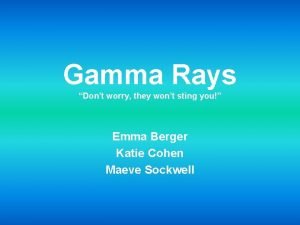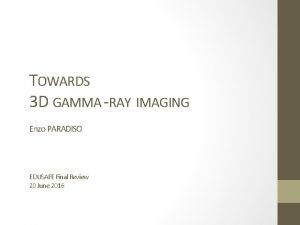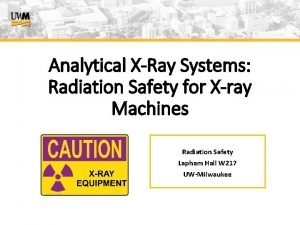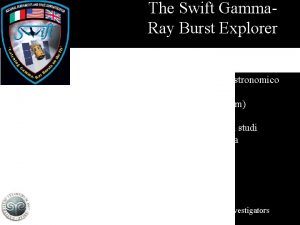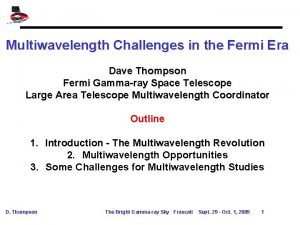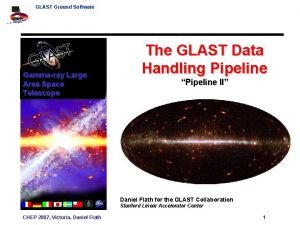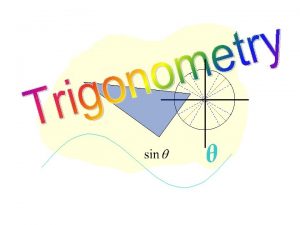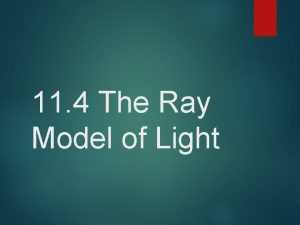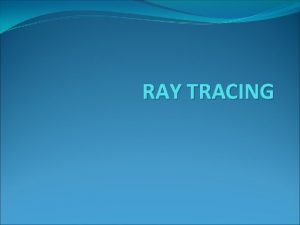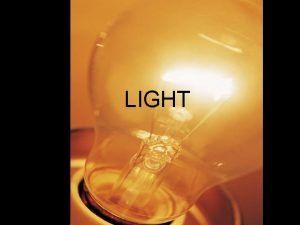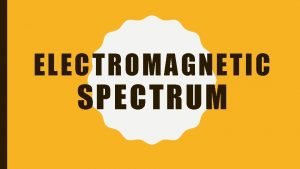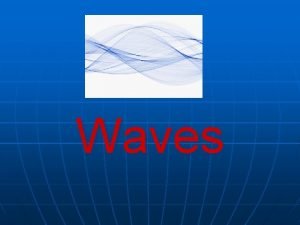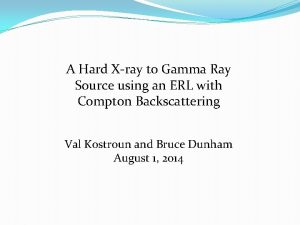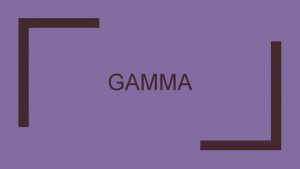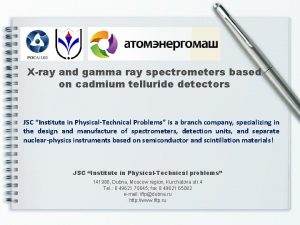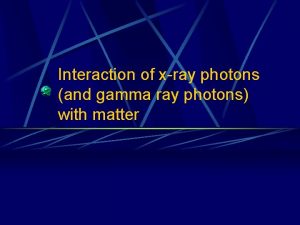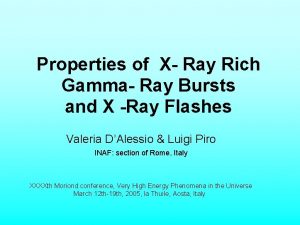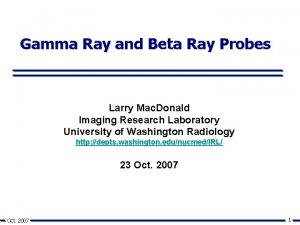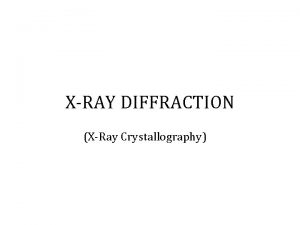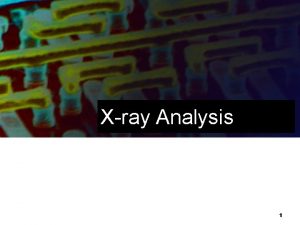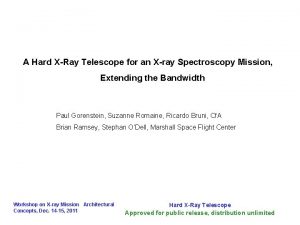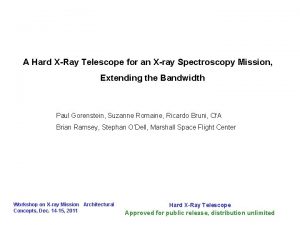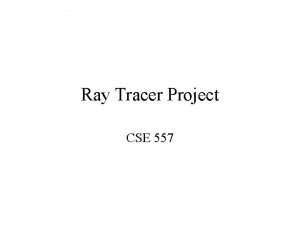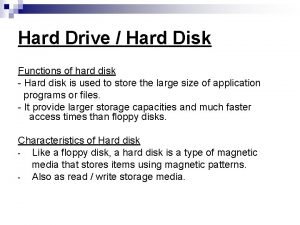A Hard Xray to Gamma Ray Source using
















- Slides: 16

A Hard X-ray to Gamma Ray Source using an ERL with Compton Backscattering Val Kostroun and Bruce Dunham August 1, 2014

Who is interested in such sources? R. Hajimi, 2 nd IZEST meeting, 2012


Lawrence Livermore National Lab FINDER – Fluorescence Imaging in the Nuclear Domain with Energetic Radiation This design uses a 250 Me. V, low average power electron linac with a ~1 Joule laser to make gamma rays for Nuclear Resonance Fluorescence measurement.

The Extreme Light Infrastructure for Nuclear Physics (ELI-NP) is now being built in Romania for $400 million. It will house 2 -10 pentawatt lasers and an 700 Me. V linac (non-ERL)

Basic inverse Compton geometry

These are expected parameters for an ERL electron beam and a laser that are used for calculating the gamma ray parameters Property Particle Energy Number of Particles Pulse Duration Focal Spot Radius Energy Spread Transverse Phase space ERL Laser

Ee= 50 Me. V Photons/s Angular distribution of radiation Integrated dose, Nx=9. 15 x 10 4 photons. For 30 k. Hz laser, (0. 005 J x 3 x 104 pulses/s = 150 W), have 2. 74 x 10 9 photons/s

Brightness at Ee= 50 Me. V s. u. -synchrotron unit = photons/(mm 2 - mrad 2 –s- 0. 1% bandwidth) -Brightness scaling

Ee=400 Me. V Photons/s Angular distribution of radiation Integrated dose, Nx=5. 37 x 10 5 photons. For 30 k. Hz laser, (0. 005 J x 3 x 104 pulses/s = 150 W), have 1. 61 x 10 10 photons/s

Brightness at Ee=400 Me. V s. u. -synchrotron unit = photons/(mm 2 - mrad 2 –s- 0. 1% bandwidth)

Possible Applications of inverse Compton scattering Assuming a photon energy range from 50 ke. V to 3 Me. V, the following applications come to mind: 1) High energy x-ray diffraction (50 -150 ke. V and higher) 2) Nuclear resonance fluorescence applications, nuclear and astrophysics 3) Special Nuclear Materials (SNM) identification High energy x-ray diffraction, advantages thereof* a) Access to high momentum transfers-this leads to high real space resolution in the pair distribution function. b) High penetration of x-rays allows experiments to be done in air and in the transmission geometry. c) Photo-absorption reduced at higher energies, so samples containing heavy elements can be used. d) Radiation damage, particularly in biological samples is greatly reduced. e) Measured structure factors and corresponding pair distribution functions are directly comparable to neutron diffraction studies measured over a similar range of momentum transfers. *C. J. Benmore, “A Review of High-Energy X-Ray Diffraction from Glasses and Liquids”, ISRN Material Science Vol. 2012, Article ID 852905

Nuclear resonance fluorescence Inverse Compton scattering off 400 Me. V electrons provides up to 3. 05 Me. V photons with a 1064 nm laser, and 6. 1 Me. V photons with a 532 nm laser. With 150 Me. V electrons, the photon range extends to 0. 43 and 0. 86 Me. V. In the ~3 Me. V photon energy range, there a number of excited states that decay to lower energy states via E 1 transitions. Possible applications include : a) Isotope analysis of samples, (the energies of the excited states formed and the emitted gamma -rays are specific to a given nucleus) b) Determination of the instantaneous velocity of the scattering nucleus c) Determination of the zero-point kinetic energy of vibration of a nucleus in a particular chemical compound or lattice * *R. Moreh, Nucl. Instr. Methods, 166, 45 (1979).

Conclusion A hard x-ray/gamma ray source utilizing Compton backscattering from a high brightness electron beam can produce high brightness photons with very narrow linewidths. Our ERL can produce short electron bunches with low emittance – the resulting photon brightness scales with 1/emittance^2 and 1/t. Combined with a high average power, high rep rate laser, a high intensity gamma ray beam can be produced. Applications range from materials research (CHESS users) on the low end (100’s of ke. V) to nuclear spectroscopy and special nuclear materials detection on the high end (1 -3 Me. V)

Peak brightness of Compton scattering light sources for head-on collisions depends on the following: The x-ray flash duration is equal to that of the electron bunch; short and compressed beams produce the highest brightness. The following are sources of spectral broadening of scattered x rays: Broadening Parameter Origin Fractional laser bandwidth Laser focusing Electron beam energy spread Electron beam focusing Nonlinear ponderomotive force Compton scattering recoil

For collinear and cylindrically symmetric beams colliding head-on, the temporal behavior of the x-ray pulse can be described by In the electron rest frame, the incident photon energy is. At 400 Me. V, this corresponds to 1. 94 ke. V, and 1. 94 ke. V << 511 ke. V, the electron rest mass, so use Thomson cross section. Two articles of interest, based on work done at LLNL: [1] "Three-dimensional time and frequency-domain theory of femto-second x-ray pulse generation through Thomson Scattering", W. J. Brown and F. V. Hartemann, Phys. Rev. STAB 7, 060703, (2004). [2] "High -energy scaling of Compton scattering light sources", F. V. Hartemann et al. , Phys. Rev. STAB 8, 100702, (2005).
 Gamma rays discovery
Gamma rays discovery Gamma ray
Gamma ray Gamma ray
Gamma ray Swift gamma ray burst explorer
Swift gamma ray burst explorer Gamma ray sky
Gamma ray sky Gamma-ray
Gamma-ray Chart of electromagnetic waves
Chart of electromagnetic waves Gamma ray burst
Gamma ray burst Terminal ray meaning
Terminal ray meaning Ray model of light
Ray model of light Ray tracing and ray casting
Ray tracing and ray casting Gravimetric analysis of calcium and hard water lab answers
Gravimetric analysis of calcium and hard water lab answers Work hard, have fun, make history
Work hard, have fun, make history Hard times hard drive
Hard times hard drive Red martians invade venus
Red martians invade venus Raging martians invade venus
Raging martians invade venus Red martians invade venus using x ray guns
Red martians invade venus using x ray guns
